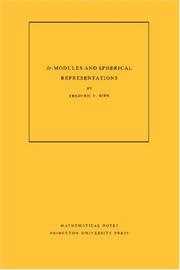| Listing 1 - 4 of 4 |
Sort by
|

ISBN: 0691000492 0691033323 1400882524 Year: 1993 Publisher: Princeton, N.J. Princeton University Press
Abstract | Keywords | Export | Availability | Bookmark
 Loading...
Loading...Choose an application
- Reference Manager
- EndNote
- RefWorks (Direct export to RefWorks)
Toric varieties are algebraic varieties arising from elementary geometric and combinatorial objects such as convex polytopes in Euclidean space with vertices on lattice points. Since many algebraic geometry notions such as singularities, birational maps, cycles, homology, intersection theory, and Riemann-Roch translate into simple facts about polytopes, toric varieties provide a marvelous source of examples in algebraic geometry. In the other direction, general facts from algebraic geometry have implications for such polytopes, such as to the problem of the number of lattice points they contain. In spite of the fact that toric varieties are very special in the spectrum of all algebraic varieties, they provide a remarkably useful testing ground for general theories.The aim of this mini-course is to develop the foundations of the study of toric varieties, with examples, and describe some of these relations and applications. The text concludes with Stanley's theorem characterizing the numbers of simplicies in each dimension in a convex simplicial polytope. Although some general theorems are quoted without proof, the concrete interpretations via simplicial geometry should make the text accessible to beginners in algebraic geometry.
Algebraic geometry --- Differential geometry. Global analysis --- 512.7 --- Algebraic geometry. Commutative rings and algebras --- Toric varieties. --- 512.7 Algebraic geometry. Commutative rings and algebras --- Toric varieties --- Embeddings, Torus --- Torus embeddings --- Varieties, Toric --- Algebraic varieties --- Addition. --- Affine plane. --- Affine space. --- Affine variety. --- Alexander Grothendieck. --- Alexander duality. --- Algebraic curve. --- Algebraic group. --- Atiyah–Singer index theorem. --- Automorphism. --- Betti number. --- Big O notation. --- Characteristic class. --- Chern class. --- Chow group. --- Codimension. --- Cohomology. --- Combinatorics. --- Commutative property. --- Complete intersection. --- Convex polytope. --- Convex set. --- Coprime integers. --- Cotangent space. --- Dedekind sum. --- Dimension (vector space). --- Dimension. --- Direct proof. --- Discrete valuation ring. --- Discrete valuation. --- Disjoint union. --- Divisor (algebraic geometry). --- Divisor. --- Dual basis. --- Dual space. --- Equation. --- Equivalence class. --- Equivariant K-theory. --- Euler characteristic. --- Exact sequence. --- Explicit formula. --- Facet (geometry). --- Fundamental group. --- Graded ring. --- Grassmannian. --- H-vector. --- Hirzebruch surface. --- Hodge theory. --- Homogeneous coordinates. --- Homomorphism. --- Hypersurface. --- Intersection theory. --- Invertible matrix. --- Invertible sheaf. --- Isoperimetric inequality. --- Lattice (group). --- Leray spectral sequence. --- Limit point. --- Line bundle. --- Line segment. --- Linear subspace. --- Local ring. --- Mathematical induction. --- Mixed volume. --- Moduli space. --- Moment map. --- Monotonic function. --- Natural number. --- Newton polygon. --- Open set. --- Picard group. --- Pick's theorem. --- Polytope. --- Projective space. --- Quadric. --- Quotient space (topology). --- Regular sequence. --- Relative interior. --- Resolution of singularities. --- Restriction (mathematics). --- Resultant. --- Riemann–Roch theorem. --- Serre duality. --- Sign (mathematics). --- Simplex. --- Simplicial complex. --- Simultaneous equations. --- Spectral sequence. --- Subgroup. --- Subset. --- Summation. --- Surjective function. --- Tangent bundle. --- Theorem. --- Topology. --- Toric variety. --- Unit disk. --- Vector space. --- Weil conjecture. --- Zariski topology.

ISBN: 1400862078 9781400862078 0691025177 9780691608327 9780691025179 0691025177 0691608326 9780691608327 Year: 2014 Publisher: Princeton, NJ
Abstract | Keywords | Export | Availability | Bookmark
 Loading...
Loading...Choose an application
- Reference Manager
- EndNote
- RefWorks (Direct export to RefWorks)
The theory of D-modules deals with the algebraic aspects of differential equations. These are particularly interesting on homogeneous manifolds, since the infinitesimal action of a Lie algebra consists of differential operators. Hence, it is possible to attach geometric invariants, like the support and the characteristic variety, to representations of Lie groups. By considering D-modules on flag varieties, one obtains a simple classification of all irreducible admissible representations of reductive Lie groups. On the other hand, it is natural to study the representations realized by functions on pseudo-Riemannian symmetric spaces, i.e., spherical representations. The problem is then to describe the spherical representations among all irreducible ones, and to compute their multiplicities. This is the goal of this work, achieved fairly completely at least for the discrete series representations of reductive symmetric spaces. The book provides a general introduction to the theory of D-modules on flag varieties, and it describes spherical D-modules in terms of a cohomological formula. Using microlocalization of representations, the author derives a criterion for irreducibility. The relation between multiplicities and singularities is also discussed at length.Originally published in 1990.The Princeton Legacy Library uses the latest print-on-demand technology to again make available previously out-of-print books from the distinguished backlist of Princeton University Press. These editions preserve the original texts of these important books while presenting them in durable paperback and hardcover editions. The goal of the Princeton Legacy Library is to vastly increase access to the rich scholarly heritage found in the thousands of books published by Princeton University Press since its founding in 1905.
Differentiable manifolds. --- D-modules. --- Representations of groups. --- Lie groups. --- Groups, Lie --- Lie algebras --- Symmetric spaces --- Topological groups --- Group representation (Mathematics) --- Groups, Representation theory of --- Group theory --- Modules (Algebra) --- Differential manifolds --- Manifolds (Mathematics) --- Affine space. --- Algebraic cycle. --- Algebraic element. --- Analytic function. --- Annihilator (ring theory). --- Automorphism. --- Banach space. --- Base change. --- Big O notation. --- Bijection. --- Bilinear form. --- Borel subgroup. --- Cartan subalgebra. --- Cofibration. --- Cohomology. --- Commutative diagram. --- Commutative property. --- Commutator subgroup. --- Complexification (Lie group). --- Conjugacy class. --- Coproduct. --- Coset. --- Cotangent space. --- D-module. --- Derived category. --- Diagram (category theory). --- Differential operator. --- Dimension (vector space). --- Direct image functor. --- Discrete series representation. --- Disk (mathematics). --- Dot product. --- Double coset. --- Eigenfunction. --- Eigenvalues and eigenvectors. --- Endomorphism. --- Euler operator. --- Existential quantification. --- Fibration. --- Function space. --- Functor. --- G-module. --- Gelfand pair. --- Generic point. --- Hilbert space. --- Holomorphic function. --- Homomorphism. --- Hyperfunction. --- Ideal (ring theory). --- Infinitesimal character. --- Inner automorphism. --- Invertible sheaf. --- Irreducibility (mathematics). --- Irreducible representation. --- Levi decomposition. --- Lie algebra. --- Line bundle. --- Linear algebraic group. --- Linear space (geometry). --- Manifold. --- Maximal compact subgroup. --- Maximal torus. --- Metric space. --- Module (mathematics). --- Moment map. --- Morphism. --- Noetherian ring. --- Open set. --- Presheaf (category theory). --- Principal series representation. --- Projective line. --- Projective object. --- Projective space. --- Projective variety. --- Reductive group. --- Riemannian geometry. --- Riemann–Hilbert correspondence. --- Right inverse. --- Ring (mathematics). --- Root system. --- Satake diagram. --- Sheaf (mathematics). --- Sheaf of modules. --- Special case. --- Sphere. --- Square-integrable function. --- Sub"ient. --- Subalgebra. --- Subcategory. --- Subgroup. --- Summation. --- Surjective function. --- Symmetric space. --- Symplectic geometry. --- Tensor product. --- Theorem. --- Triangular matrix. --- Vector bundle. --- Volume form. --- Weyl group.
Book
ISBN: 0691080771 1322886709 0691621365 1400871239 0691648026 9780691080772 Year: 1976 Publisher: Princeton (N.J.): Princeton university press
Abstract | Keywords | Export | Availability | Bookmark
 Loading...
Loading...Choose an application
- Reference Manager
- EndNote
- RefWorks (Direct export to RefWorks)
Global analysis describes diverse yet interrelated research areas in analysis and algebraic geometry, particularly those in which Kunihiko Kodaira made his most outstanding contributions to mathematics. The eminent contributors to this volume, from Japan, the United States, and Europe, have prepared original research papers that illustrate the progress and direction of current research in complex variables and algebraic and differential geometry. The authors investigate, among other topics, complex manifolds, vector bundles, curved 4-dimensional space, and holomorphic mappings. Bibliographies facilitate further reading in the development of the various studies.Originally published in 1970.The Princeton Legacy Library uses the latest print-on-demand technology to again make available previously out-of-print books from the distinguished backlist of Princeton University Press. These editions preserve the original texts of these important books while presenting them in durable paperback and hardcover editions. The goal of the Princeton Legacy Library is to vastly increase access to the rich scholarly heritage found in the thousands of books published by Princeton University Press since its founding in 1905.
Differential geometry. Global analysis --- Global analysis (Mathematics) --- Calculus of variations --- Differentiable manifolds --- 517.97 --- Analysis, Global (Mathematics) --- Differential topology --- Functions of complex variables --- Geometry, Algebraic --- Calculus of variations. Mathematical theory of control --- Differentiable manifolds. --- Calculus of variations. --- Global analysis (Mathematics). --- 517.97 Calculus of variations. Mathematical theory of control --- Algebraic topology --- 514.7 --- -Calculus of variations --- #TCPW W3.0 --- #TCPW W3.2 --- #WWIS:MEET --- Differential manifolds --- Manifolds (Mathematics) --- Isoperimetrical problems --- Variations, Calculus of --- Maxima and minima --- Differential geometry. Algebraic and analytic methods in geometry --- 514.7 Differential geometry. Algebraic and analytic methods in geometry --- Addresses, essays, lectures --- Functional analysis --- Geometry --- Algebra homomorphism. --- Algebraic space. --- Associated graded ring. --- Automorphism. --- Betti number. --- Bilinear form. --- Canonical basis. --- Canonical bundle. --- Closed immersion. --- Codimension. --- Coefficient. --- Cohomology. --- Cokernel. --- Complete intersection. --- Complex manifold. --- Complex torus. --- Convex cone. --- Covering space. --- Dedekind domain. --- Deformation theory. --- Degenerate bilinear form. --- Diagram (category theory). --- Diffeomorphism. --- Differential form. --- Discrete group. --- Discrete valuation ring. --- Divisor. --- Elliptic operator. --- Elliptic surface. --- Endomorphism. --- Enriques surface. --- Epimorphism. --- Equation. --- Exact sequence. --- Existential quantification. --- Extremal length. --- Fiber bundle. --- Flat morphism. --- Frame bundle. --- Functor. --- Generic point. --- Grassmannian. --- Harmonic function. --- Heine–Borel theorem. --- Hensel's lemma. --- Holomorphic function. --- Homogeneous coordinates. --- Homomorphism. --- Hyperplane. --- Invertible sheaf. --- Kodaira embedding theorem. --- Kodaira vanishing theorem. --- Lie algebra. --- Line bundle. --- Linear independence. --- Linear map. --- Local ring. --- Mathematical induction. --- Meromorphic function. --- Metric space. --- Morphism. --- Natural number. --- Norm (mathematics). --- Normal extension. --- Normal subgroup. --- Open set. --- Orientability. --- Orthonormal basis. --- Partition of unity. --- Polynomial. --- Principal bundle. --- Principal homogeneous space. --- Projection (mathematics). --- Projective line. --- Quadric. --- Rational singularity. --- Residue field. --- Riemannian manifold. --- Ring homomorphism. --- Self-adjoint operator. --- Sheaf (mathematics). --- Sobolev space. --- Special case. --- Stokes' theorem. --- Subgroup. --- Submanifold. --- Subset. --- Subspace theorem. --- Summation. --- Surjective function. --- Symmetric tensor. --- Symplectic vector space. --- Tangent space. --- Theorem. --- Universal bundle. --- Upper and lower bounds. --- Vector bundle. --- Vector field. --- Wirtinger inequality (2-forms). --- Zariski topology. --- Analyse globale (mathématiques) --- Calcul des variations --- Analyse globale (mathématiques) --- Kodaira (kunihiko), mathematicien japonais, 1915 --- -Kodaira (kunihiko), mathematicien japonais, 1915 --- -517.97 --- -Analyse globale (mathématiques) --- -Algebraic topology

ISBN: 0691082383 1400883989 Year: 1980 Publisher: Princeton (N.J.): Princeton university press
Abstract | Keywords | Export | Availability | Bookmark
 Loading...
Loading...Choose an application
- Reference Manager
- EndNote
- RefWorks (Direct export to RefWorks)
One of the most important mathematical achievements of the past several decades has been A. Grothendieck's work on algebraic geometry. In the early 1960s, he and M. Artin introduced étale cohomology in order to extend the methods of sheaf-theoretic cohomology from complex varieties to more general schemes. This work found many applications, not only in algebraic geometry, but also in several different branches of number theory and in the representation theory of finite and p-adic groups. Yet until now, the work has been available only in the original massive and difficult papers. In order to provide an accessible introduction to étale cohomology, J. S. Milne offers this more elementary account covering the essential features of the theory. The author begins with a review of the basic properties of flat and étale morphisms and of the algebraic fundamental group. The next two chapters concern the basic theory of étale sheaves and elementary étale cohomology, and are followed by an application of the cohomology to the study of the Brauer group. After a detailed analysis of the cohomology of curves and surfaces, Professor Milne proves the fundamental theorems in étale cohomology -- those of base change, purity, Poincaré duality, and the Lefschetz trace formula. He then applies these theorems to show the rationality of some very general L-series.Originally published in 1980.The Princeton Legacy Library uses the latest print-on-demand technology to again make available previously out-of-print books from the distinguished backlist of Princeton University Press. These editions preserve the original texts of these important books while presenting them in durable paperback and hardcover editions. The goal of the Princeton Legacy Library is to vastly increase access to the rich scholarly heritage found in the thousands of books published by Princeton University Press since its founding in 1905.
Ordered algebraic structures --- 512.73 --- 512.66 --- Geometry, Algebraic --- Homology theory --- Sheaf theory --- Cohomology, Sheaf --- Sheaf cohomology --- Sheaves, Theory of --- Sheaves (Algebraic topology) --- Algebraic topology --- Cohomology theory --- Contrahomology theory --- Algebraic geometry --- Geometry --- Cohomology theory of algebraic varieties and schemes --- Homological algebra --- Geometry, Algebraic. --- Homology theory. --- Sheaf theory. --- 512.66 Homological algebra --- 512.73 Cohomology theory of algebraic varieties and schemes --- Abelian category. --- Abelian group. --- Adjoint functors. --- Affine variety. --- Alexander Grothendieck. --- Algebraic closure. --- Algebraic cycle. --- Algebraic equation. --- Algebraic space. --- Algebraically closed field. --- Artinian. --- Automorphism. --- Base change. --- Brauer group. --- CW complex. --- Cardinal number. --- Category of sets. --- Central simple algebra. --- Chow's lemma. --- Closed immersion. --- Codimension. --- Cohomology ring. --- Cohomology. --- Cokernel. --- Commutative diagram. --- Complex number. --- Dedekind domain. --- Derived category. --- Diagram (category theory). --- Direct limit. --- Discrete valuation ring. --- Divisor. --- Epimorphism. --- Equivalence class. --- Existential quantification. --- Fibration. --- Field of fractions. --- Fine topology (potential theory). --- Finite field. --- Finite morphism. --- Flat morphism. --- Functor. --- Fundamental class. --- Fundamental group. --- G-module. --- Galois cohomology. --- Galois extension. --- Galois group. --- Generic point. --- Group scheme. --- Gysin sequence. --- Henselian ring. --- Identity element. --- Inclusion map. --- Integral domain. --- Intersection (set theory). --- Inverse limit. --- Invertible sheaf. --- Isomorphism class. --- Lefschetz pencil. --- Local ring. --- Maximal ideal. --- Module (mathematics). --- Morphism of schemes. --- Morphism. --- Noetherian. --- Open set. --- Power series. --- Presheaf (category theory). --- Prime ideal. --- Prime number. --- Principal homogeneous space. --- Profinite group. --- Projection (mathematics). --- Projective variety. --- Quasi-compact morphism. --- Residue field. --- Riemann surface. --- Sheaf (mathematics). --- Sheaf of modules. --- Special case. --- Spectral sequence. --- Stein factorization. --- Subalgebra. --- Subcategory. --- Subgroup. --- Subring. --- Subset. --- Surjective function. --- Tangent space. --- Theorem. --- Topological space. --- Topology. --- Torsion sheaf. --- Torsor (algebraic geometry). --- Vector bundle. --- Weil conjecture. --- Yoneda lemma. --- Zariski topology. --- Zariski's main theorem. --- Geometrie algebrique --- Cohomologie
| Listing 1 - 4 of 4 |
Sort by
|

 Search
Search Feedback
Feedback About UniCat
About UniCat  Help
Help News
News